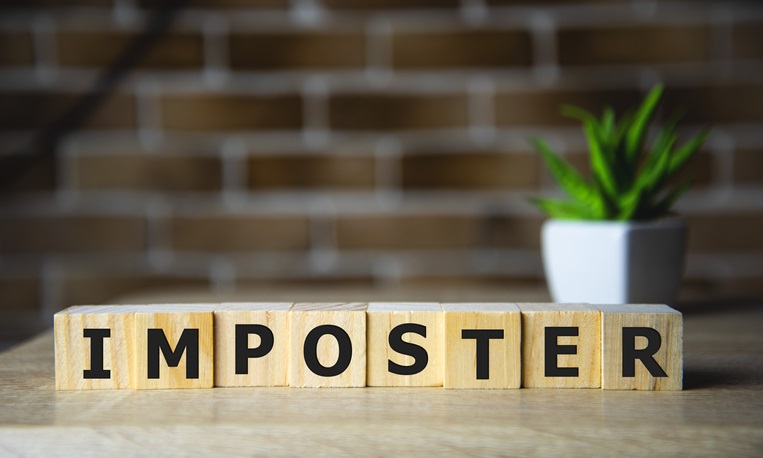
Summer 2023

Imposter Phenomena
Melinda Furer, PhD1 & the Evidence-Based Behavioral Medicine SIG
Imposter phenomena are a constellation of experiences that center on feelings of self-doubt and fraudulence (Slank, 2019). When we experience imposter phenomenon we have the sense that we have not earned our status or achievement through our abilities, but rather through deceit or luck.
Imposter phenomena are prevalent, affecting up to 82% of the population, and impacts us regardless of age, gender or racial/ethnic identity (Bravata, Madhusudhan, Boroff, & Cokley, 2020). Although we can experience imposter phenomenon in any personal sphere, the bulk of research on the topic examines work and school. Individuals in all stages of professional development (from secondary education students to veteran leaders) report being bothered by feeling undeserving of their position (Bravata et al., 2020).
Aside from being distressing, experiencing imposter phenomenon is associated with higher incidence of conflict at school/work, poorer work/life balance, and less success (e.g., poorer grades, worse performance reviews; Parkman, 2016). Imposter phenomenon is also associated with comorbid mood disorders (Cusack, Hughes, & Nuhu, 2013).
Historically marginalized groups, including ethnic minorities, women, queer and transgender individuals, and those with disabilities are particularly vulnerable to the imposter phenomenon (Nadal, King, Sissoko, Floyd, & Hines, 2021). Individuals in these groups have been shown to be at risk for internalized oppressive views and experiencing stereotype threat, both of which may reinforce their self-image as an “imposter” (Martin, 2018). Ill-prepared teachers, advisors, and employers may exacerbate imposter phenomenon by committing microaggressions and/or contributing to racial battle fatigue (Nadal et al., 2021). Thus, imposter phenomena are a significant barrier to recruitment and retention of diverse individuals in higher education and across professional fields.
Although systemic changes are needed to fully address the experience of imposter phenomenon and its negative side effects, individuals can work towards personal relief from its symptoms. The ultimate goal when working to manage the imposter phenomenon is to adjust the negative self-talk which describes us as undeserving or fradulent. This can be done using these three simple tools:
- Cognitive Restructuring: Cognitive restructuring is a cognitive-behavioral therapeutic technique that involves recording our unhelpful thoughts (e.g., “I have no idea what I’m doing”) and challenging them with more realistic ones (e.g., “I have more to learn”).
- Detailed Visualization: Detailed visualization involves visualizing what success may look like–when we struggle with feelings of self-doubt or undeservedness we tend to ignore and discount the possibility of success. This tool can be particularly helpful when we have a concrete task, like an interview or presentation. Asking ourselves what the environment will be like (who will be there, what will our surroundings be), how it will feel to be confident, relaxed and prepared, or what it may look like to successfully overcome challenges, can help us generate an immersive picture of what we can achieve.
- Self-Disclosure: Self-disclosure about our feelings of fraudulent with trusted mentors and peers, while often anxiety provoking (why would we want to out ourselves?) has been shown to be a key step in working through imposter phenomenon (DeCandia, 2021).
Want more?
- Tweet your thoughts on imposter phenomenon to our Twitter thread or tag us with #SBMEvidence to join the conversation!
- SBM members can view Dr. Furer’s SBM webinar, Imposter Syndrome and Burnout: Finding Balance in Training and Early Career, online. https://www.sbm.org/training/webinars/webinar-recordings/recording/web230406
References
Bravata, D. M., Madhusudhan, D. K., Boroff, M., & Cokley, K. O. (2020). Commentary: Prevalence, predictors, and treatment of imposter syndrome: A systematic review. Journal of Mental Health & Clinical Psychology, 4(3).
Cusack, C. E., Hughes, J. L., & Nuhu, N. (2013). Connecting Gender and Mental Health to Imposter Phenomenon Feelings. Psi Chi Journal of Psychological Research, 18(2).
DeCandia Vitoria, A. (2021). Experiential supervision: Healing imposter phenomenon from the inside out. The Clinical Supervisor, 40(2), 200-217.
Martin, J. L. (2018). Factors contributing to microaggressions, racial battle fatigue, stereotype threat, and imposter phenomenon for nonhegemonic students: Implications for urban education. Microaggression theory: Influence and implications, 102-120.
Nadal, K. L., King, R., Sissoko, D. G., Floyd, N., & Hines, D. (2021). The legacies of systemic and internalized oppression: Experiences of microaggressions, imposter phenomenon, and stereotype threat on historically marginalized groups. New Ideas in Psychology, 63, 100895.
Parkman, A. (2016). The imposter phenomenon in higher education: Incidence and impact. Journal of Higher Education Theory & Practice, 16(1).
Slank, S. (2019). Rethinking the imposter phenomenon. Ethical Theory and Moral Practice, 22(1), 205-218.
Affiliations
- Assistant Professor of Psychology at Penn State Altoona